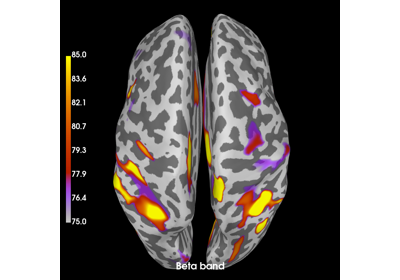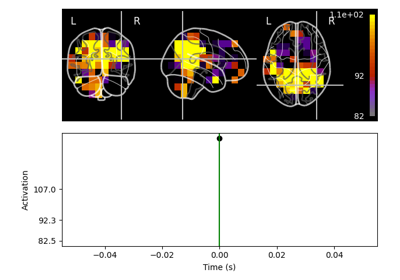mne_connectivity.TemporalConnectivity¶
- class mne_connectivity.TemporalConnectivity(data, times, n_nodes, names=None, indices='all', method=None, n_epochs_used=None, **kwargs)[source]¶
Temporal connectivity class.
This is an array of shape (n_connections, n_times), or (n_nodes, n_nodes, n_times). This describes how connectivity varies over time. It describes sample-by-sample time-varying connectivity (usually on the order of milliseconds). Here time (t=0) is the same for all connectivity measures.
- Parameters
data : np.ndarray ([epochs], n_estimated_nodes, [freqs], [times])
The connectivity data that is a raveled array of
(n_estimated_nodes, ...)shape. Then_estimated_nodesis equal ton_nodes_in * n_nodes_outif one is computing the full connectivity, or a subset of nodes equal to the length ofindicespassed in.times : list | np.ndarray
The times at which the connectivity data is computed over.
n_nodes : int
The number of nodes in the dataset used to compute connectivity. This should be equal to the number of signals in the original dataset.
names : list | np.ndarray | None
The names of the nodes of the dataset used to compute connectivity. If ‘None’ (default), then names will be a list of integers from 0 to
n_nodes. If a list of names, then it must be equal in length ton_nodes.indices : tuple of arrays | str | None
The indices of relevant connectivity data. If
'all'(default), then data is connectivity between all nodes. If'symmetric', then data is symmetric connectivity between all nodes. If a tuple, then the first list represents the “in nodes”, and the second list represents the “out nodes”. See “Notes” for more information.method : str, optional
The method name used to compute connectivity.
n_epochs_used : int, optional
The number of epochs used in the computation of connectivity, by default None.
Notes
mne_connectivity.EpochConnectivityis a similar connectivity class to this one. However, that describes one connectivity snapshot for each epoch. These epochs might be chunks of time that have different meaning for timet=0. Epochs can mean separate trials, where the beginning of the trial implies t=0. These Epochs may also be discontiguous.- Attributes
-
Xarray attributes of connectivity.
The coordinates of the xarray data.
The dimensions of the xarray data.
Indices of connectivity data.
The method used to compute connectivity.
Number of epochs used in computation of connectivity.
The number of nodes in the original dataset.
Node names.
Shape of raveled connectivity.
The time points of the connectivity data.
Xarray of the connectivity data.
Methods
get_data([output])Get connectivity data as a numpy array.
plot_circle(**kwargs)Visualize connectivity as a circular graph.
predict(data)Predict samples on actual data.
rename_nodes(mapping)Rename nodes.
save(fname)Save connectivity data to disk.
simulate(n_samples[, noise_func, random_state])Simulate vector autoregressive (VAR) model.
- property attrs¶
Xarray attributes of connectivity.
See
xarray’sattrs.
- property coords¶
The coordinates of the xarray data.
- property dims¶
The dimensions of the xarray data.
- get_data(output='compact')¶
Get connectivity data as a numpy array.
- Parameters
output : str, optional
How to format the output, by default ‘raveled’, which will represent each connectivity matrix as a
(n_nodes_in * n_nodes_out,)list. If ‘dense’, then will return each connectivity matrix as a 2D array. If ‘compact’ (default) then will return ‘raveled’ ifindiceswere defined as a list of tuples, ordenseif indices is ‘all’.- Returns
data : np.ndarray
The output connectivity data.
- property indices¶
Indices of connectivity data.
- Returns
indices : str | tuple of lists
Either ‘all’ for all-to-all connectivity, ‘symmetric’ for symmetric all-to-all connectivity, or a tuple of lists representing the node-to-nodes that connectivity was computed.
- property method¶
The method used to compute connectivity.
- property n_epochs_used¶
Number of epochs used in computation of connectivity.
Can be ‘None’, if there was no epochs used.
- property n_nodes¶
The number of nodes in the original dataset.
Even if
indicesdefines a subset of nodes that were computed, this should be the total number of nodes in the original dataset.
- property names¶
Node names.
- plot_circle(**kwargs)¶
Visualize connectivity as a circular graph.
- Parameters
node_names : list of str
Node names. The order corresponds to the order in con.
indices : tuple of array | None
Two arrays with indices of connections for which the connections strengths are defined in con. Only needed if con is a 1D array.
n_lines : int | None
If not None, only the n_lines strongest connections (strength=abs(con)) are drawn.
node_angles : array, shape (n_node_names,) | None
Array with node positions in degrees. If None, the nodes are equally spaced on the circle. See mne.viz.circular_layout.
node_width : float | None
Width of each node in degrees. If None, the minimum angle between any two nodes is used as the width.
node_colors : list of tuple | list of str
List with the color to use for each node. If fewer colors than nodes are provided, the colors will be repeated. Any color supported by matplotlib can be used, e.g., RGBA tuples, named colors.
facecolor : str
Color to use for background. See matplotlib.colors.
textcolor : str
Color to use for text. See matplotlib.colors.
node_edgecolor : str
Color to use for lines around nodes. See matplotlib.colors.
linewidth : float
Line width to use for connections.
colormap : str | instance of matplotlib.colors.LinearSegmentedColormap
Colormap to use for coloring the connections.
vmin : float | None
Minimum value for colormap. If None, it is determined automatically.
vmax : float | None
Maximum value for colormap. If None, it is determined automatically.
colorbar : bool
Display a colorbar or not.
title : str
The figure title.
colorbar_size : float
Size of the colorbar.
colorbar_pos : tuple, shape (2,)
Position of the colorbar.
fontsize_title : int
Font size to use for title.
fontsize_names : int
Font size to use for node names.
fontsize_colorbar : int
Font size to use for colorbar.
padding : float
Space to add around figure to accommodate long labels.
fig : None | instance of matplotlib.figure.Figure
The figure to use. If None, a new figure with the specified background color will be created.
subplot : int | tuple, shape (3,)
Location of the subplot when creating figures with multiple plots. E.g. 121 or (1, 2, 1) for 1 row, 2 columns, plot 1. See matplotlib.pyplot.subplot.
interactive : bool
When enabled, left-click on a node to show only connections to that node. Right-click shows all connections.
node_linewidth : float
Line with for nodes.
show : bool
Show figure if True.
- Returns
fig : instance of matplotlib.figure.Figure
The figure handle.
axes : instance of matplotlib.projections.polar.PolarAxes
The subplot handle.
Notes
This code is based on a circle graph example by Nicolas P. Rougier
By default,
matplotlib.pyplot.savefig()does not takefacecolorinto account when saving, even if set when a figure is generated. This can be addressed via, e.g.:>>> fig.savefig(fname_fig, facecolor='black')
If
facecoloris not set viamatplotlib.pyplot.savefig(), the figure labels, title, and legend may be cut off in the output figure.
- predict(data)¶
Predict samples on actual data.
The result of this function is used for calculating the residuals.
- Parameters
data : array
Epoched or continuous data set. Has shape (n_epochs, n_signals, n_times) or (n_signals, n_times).
- Returns
predicted : array
Data as predicted by the VAR model of shape same as
data.
Notes
Residuals are obtained by r = x - var.predict(x).
To compute residual covariances:
# compute the covariance of the residuals # row are observations, columns are variables t = residuals.shape[0] sampled_residuals = np.concatenate( np.split(residuals[:, :, model_order:], t, 0), axis=2 ).squeeze(0) rescov = np.cov(sampled_residuals)
- rename_nodes(mapping)¶
Rename nodes.
- Parameters
mapping : dict
Mapping from original node names (keys) to new node names (values).
- save(fname)¶
Save connectivity data to disk.
- Parameters
fname : str | pathlib.Path
The filepath to save the data. Data is saved as netCDF files (
.ncextension).
- property shape¶
Shape of raveled connectivity.
- simulate(n_samples, noise_func=None, random_state=None)¶
Simulate vector autoregressive (VAR) model.
This function generates data from the VAR model.
- Parameters
n_samples : int
Number of samples to generate.
noisefunc : func, optional
This function is used to create the generating noise process. If set to None, Gaussian white noise with zero mean and unit variance is used.
- Returns
data : array, shape (n_samples, n_channels)
Generated data.
- property times¶
The time points of the connectivity data.
- property xarray¶
Xarray of the connectivity data.

